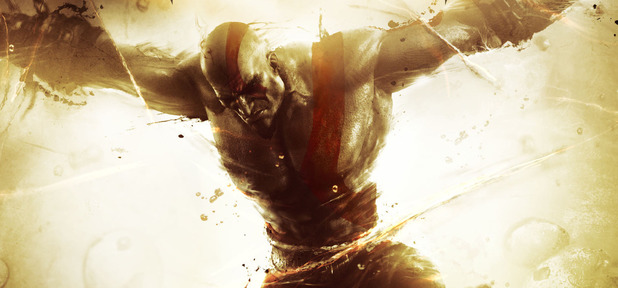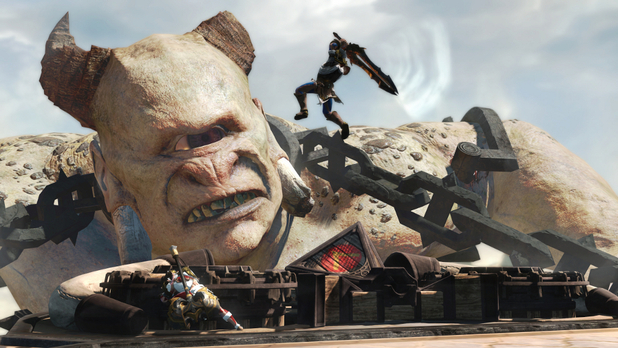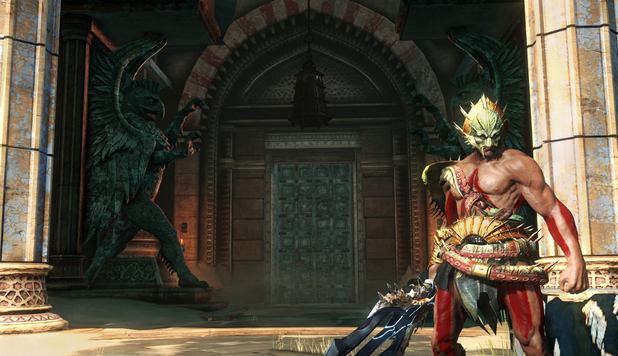
God of War: Ascension – the latest instalment that takes place before the events of the original trilogy – was released this week worldwide on PlayStation 3.
As well as presenting a more human side of protagonist Kratos, and set in a time before his desire for vengeance consumed him, it’s also the first in the series to introduce multiplayer.
But how did developer Santa Monica Studios approach adding the new mode? We chat to two development leads on how it approached multiplayer, the helping hand it received from Uncharted studio Naughty Dog and the difficulties of balancing once it reached the player’s hands.
> Our review of ‘God of War: Ascension’: Another epic adventure
Why add multiplayer to ‘God of War’?
Lead combat designer Jason McDonald said that the decision to add multiplayer was “driven” by lead director Todd Papy’s interest in new gameplay and design ideas.
“The part he was interested in, was what we could do and possibilities there were for multiplayer for God of War,” he told Digital Spy. “We tried it out to see where it brought us, and it brought us here.”

It’s eight years since God of War first debuted on PS2 in 2005, and Ascension is the fourth in the series. Why only introduce multiplayer now?
“I wish we could have done it sooner, based on the experience we took on Ascension,” lead game designer Mark Simon said.
“But everybody’s in different roles than they were when God of War 1 or 2 and 3 [were released], and the situations were all vastly different from one another.
“This was the first chance the studio, I think, was able to go, ‘You know what? We’re going to do multiplayer and it’s going to be a AAA part of our game, not just something we throw in there. It’s going to be a big part of what we’re doing’.”
The studio found that it was important to introduce the mode as a core part of the design, and that it was done in-house and not outsourced to another studio.

“We’ve seen other companies do this, unfortunately, where there’s a multiplayer part of the game that’s very small or clearly unsupported, and we knew we didn’t want to do that,” said McDonald.
Simon added: “We’re not having some other studio somewhere half way across the universe working on multiplayer for us.”
With both single and multiplayer teams under one roof, development saw any new ideas flow between the two teams.
“We have the same design group that sits in the same big design group meeting that’s filled with guys concentrating on a multiplayer level sitting next to a guy who’s concentrating on a single player level,” said Simon.
“And that’s cool, because they’re essentially giving each other feedback on each other’s levels and creatures that they’re dealing with. The best way, I think, to operate is to keep in the same space.”
McDonald added: “Not everything that was originally designed for single player was there from the start – some of it might have trickled into multiplayer, and some of the multiplayer trickled into single player as well.”
A helping hand from ‘Uncharted’ studio Naughty Dog
God of War isn’t the first single-player series to adopt multiplayer. Uncharted, created by fellow first-party studio Naughty Dog, added the feature in the game’s second instalment in 2008.
Members of Naughty Dog gave Santa Monica Studios advice on the “pitfalls” of the development process, as well as going hands-on to try it out themselves.
“We’re so lucky that our studio is just down the street from those guys,” said Simon.
“We don’t get to talk to them everyday, or go to lunch with them everyday, but we do get to talk to them frequently about some of the pitfalls of multiplayer development.
“We did ping them on a regular basis, and maybe annoyingly so to them, because we were always asking them questions about stuff, and we wanted them to come over and play things before we were getting ready to do stuff in some instances.
“They’re gracious enough to cruise down and play it and give us feedback.”

The task of balancing a multiplayer game out in the wild
The first prototypes of God of War multiplayer – which saw the same characters and weapons face off against one another – proved that it was a fun experience, but the big problem the team faced was balancing.
Balancing was one of the core challenges of multiplayer, something which only escalated as it went into people’s hands.
“[Balancing] was definitely a persistent challenge and something we’re going to be tuning well after the game’s release as well, looking at people’s feedback, watching people play, and making sure that we keep it as fun as possible,” explained McDonald.
“The thing about multiplayer is that you never know what players are going to do. Depending who’s picking up the controller, depending on what their mindset is, they may do something that you didn’t expect.”
Simon described it as “almost an entirely different difficulty setting”, where unpredictable player behaviours are much smarter than anything the coded, computer competitor could do.

“It’s very different from single player, where I pretty much I know everything an enemy is capable of,” added McDonald.
“I have no idea what Mark is going to do when he picks up the controller, so whatever you were thinking changes immediately when you see other people play.
“That’s why when the game gets released, we’re going to have a mass audience playing it, and that’s going to give us the best feedback.”
The team received some of that feedback as part of the beta leading up to release, which led to some interesting – but sometimes conflicting – data.
Many players thought that Zeus was overpowered, especially against Ares, a character who had no protection against him. However, that didn’t stop people playing as Aries.
“You find that they can complain about Zeus being overpowered, but then more of the 60% of the players played Ares,” explained Simon.
“More than the majority of the kills – probably because there are more Ares than Zeus players – have more kills.
“An open beta is so interesting because you have a vocal group that will say a thing, and then we look statistically and things will be a little bit different. And somewhere between both of these things is essentially the truth.
“And we basically need to take all that information and basically cypher it, and go, ‘This is what we’re going to do’.”
Simon added that this feedback – where users suggest something wrong despite having the right gut “feeling” – is the trickiest part of the design.
What’s next for ‘God of War: Ascension’?
Multiplayer in all games thrives on new content to sustain its community in the weeks and months after release.
Ascension is confirmed to have both ongoing balancing updates and dedicated DLC, but aside from pre-order skins and other bonus items, what exactly extra content will be is still under wraps.
“One thing that fans can count of is that we’re going to continue to support Ascension after its release,” explained Simon.
“We’re continuing to work on it right after the point where we left for this trip [in early February] and we’ll continue to work on it when we get back.”
‘God of War: Ascension’ is available now exclusively on PS3
Related articles
- ‘God of War: Ascension’: How multiplayer was introduced to the series (digitalspy.co.uk)
- God of War: Ascension multiplayer began during GoW 3 development (vg247.com)
- ‘God of War: Ascension’ Review – Portrait Of A Young Kratos (multiplayerblog.mtv.com)
- Check Out Some More Multiplayer From God of War: Ascension (webpronews.com)
Filed under: cult news, digital spy, Unusual Musings Tagged: Ascension, God of War, god-of-war-ascension, multiplayer, PlayStation 3, Sony, Uncharted, Video Games
